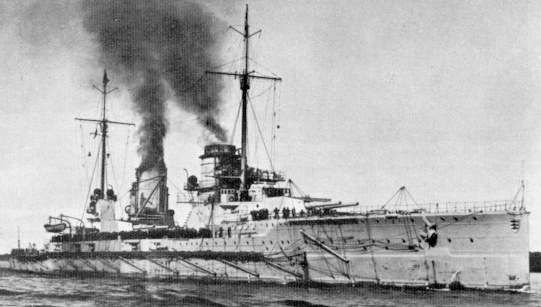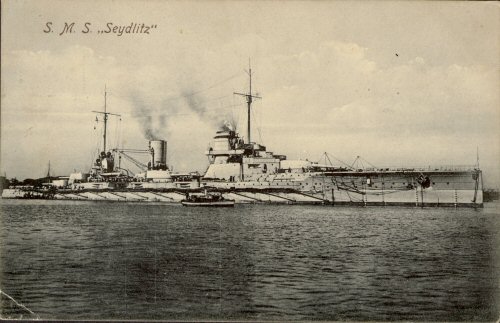
Battlecruiser (2f/2m). L/B/D: 658.0 × 93.5 × 30.5 (200.6m × 28.5m × 9.3m). Tons: 28,550 disp. Hull: steel. Comp.: 1,143. Arm.: 10 × 11.2 (5 × 2), 12 × 6, 12 × 8.8cm; 4 × 20TT. Armor: 12 belt, 3.2 deck. Mach.: turbines, 89,738 shp, 4 screws; 28.1 kts. Built: Blohm & Voss, Hamburg; 1913.
Essentially an improved Moltke-class cruiser and thus quite similar in appearance and design to SMS Goeben, SMS Seydlitz was one of the most battle-hardened ships of the Imperial German Navy. Named for the eighteenth-century cavalry officer Friedrich Wilhelm von Seydlitz, the cruiser was the flagship of Rear Admiral Franz von Rear Admiral Franz von Hipper's First Reconnaissance Group, stationed at Wilhelmshaven.
On November 3 and December 16, 1914, Hipper's battlecruisers bombarded British coastal defenses at Yarmouth and Hartlepool. On January 24, 1915, Seydlitz sortied at the head of an eight-ship group, including the heavy cruisers Moltke, Derfflinger, and Blucher, and four light cruisers. The British deployed Vice Admiral David Beatty's First and Second Battle Cruiser Squadrons, supported by units from Rosyth, Harwich, and Scapa Flow. Action opened between light cruisers, and Hipper quickly realized that he was dangerously outgunned. In the ensuing chase, Seydlitz's two after turrets were knocked out and she lost 165 crew; the older Blücher was sunk with the loss of 792 lives. British losses were light, although Beatty's flagship HMS Lion required four months of repairs. But Seydlitz's battle damage resulted in improvements to deck armor and antiflash protection in the magazines that gave the German fleet—and Seydlitz in particular—a dramatic advantage at the The Battle of Jutland.
After repairs, Seydlitz served in the Baltic before returning to the North Sea. Damaged by a mine on an ineffectual raid against Lowestoft and Yarmouth on April 25, 1916, she was again battleworthy by the time the High Seas Fleet sailed in an effort to engage the Royal Navy's Grand Fleet. Hipper's battlecruisers fired the opening salvos of the The Battle of Jutland at 1547. Shortly after 1600, Von der Tann sank HMS Indefatigable and fifteen minutes later, coordinated fire from Seydlitz and Derfflinger sank HMS Queen Mary. Before the afternoon was out, Seydlitz had received 23 hits and had been torpedoed by the destroyer HMS Petard; with 5,300 tons of water in her hull and well down at the head she limped back to port. Repairs lasted four months, but for all intents and purposes Seydlitz's war was over, as it was for most of the German surface fleet.
On November 21, 1918, Seydlitz led 74 ships of the Imperial German Navy into internment at Scapa Flow under the armistice agreement that brought hostilities to a close. Weighed down by the humiliation of his ignominious surrender to the British, Admiral Ludwig von Reuter ordered the German Fleet to scuttle itself on June 21, 1919, one week before the Versailles Peace Treaty was ratified. Seydlitz rolled over and sank in about 70 feet of water.
Seydlitz lay at Scapa Flow with about 25 feet of her hull exposed until November 2, 1928, when after more than 40 attempts she was refloated by the Cox and Danks Ltd. salvage company. Towed to Rosyth the following year, she was broken up in 1930.

